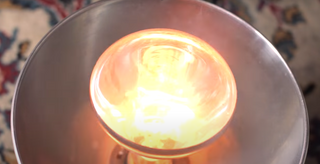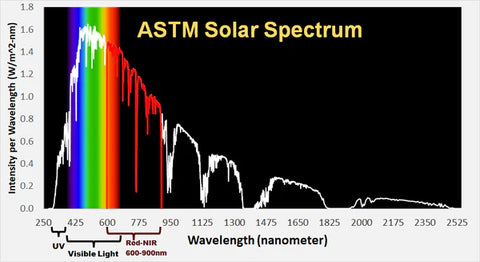“Penetrating red light is possibly the fundamental anti-stress factor for all organisms. The chronic deficiency of such light is, I think, the best explanation for the deterioration which occurs with aging. Enzyme changes, free radical changes, structural and respiratory changes are all involved as consequences of darkness stress.” – Raymond Peat, Ph.D.
It seems a lot of people are finally starting to appreciate the forgotten significance of sunlight. That it's not all doom and gloom but rather necessary and fundamental.
We’re connecting dots that reveal just how critical sun exposure is for our mental, physical, cellular, and metabolic health– ancient truths resurfacing.
(if you’re still scratching your head on this subject, read our post about sun here.)
So what does this reality mean for us in the colder, darker months when we wear extra layers and spend more time indoors? (when we get to work before the sun rises and drive home in the dark)
It’s really no wonder roughly 15% of Canadians and 20% of Americans experience some form of seasonal depression during this time.
Not only does this lack of light derail our emotional well-being, but it’s also linked to less vibrant skin, thinner hair, and increased disease.
Since this season makes up more than half the year for many of us, we must find ways to mitigate the “darkness stress” even in the absence of sunlight.
Enter red light therapy.
This form of photomedicine is making quite a name for itself in the holistic health space for the way it positively affects cellular function.
Though our biology benefits from the full spectrum of the sun, red light is particularly helpful in energizing the cell’s mitochondria and stimulating the metabolism. (1)
Let’s look at why red light therapy is much more than a wellness trend, important things to keep in mind, and how you can get the most out of your sessions with bioenergetic skincare.
What exactly is red light therapy?
Red light therapy is a non-invasive treatment that uses low-wavelength red light on the skin to stimulate blood flow and rejuvenate cellular function.
Studies reveal that red light therapy can help with everything from skin health and hair growth to injury and infection recovery. (2)
How it works. What’s so special about red light?
Each color of the spectrum of visible light is a different wavelength.
Violet has the shortest wavelength of about 380 nanometers, while red has the longest wavelength of around 700 nanometers.
Most red light therapy devices give off wavelengths between 600 nm to 900 nm.
When this light hits your skin, it triggers photoreceptor proteins in your cells' mitochondria to produce more energy. When the cells in your body have more energy, they can renew and repair damage much more efficiently.
It also boosts blood flow to help bring more oxygen and nutrients into your body's cells and tissues for faster recovery and lower overall inflammation.
The first red light.
The original “red light therapy device” has been hanging in the sky since the beginning of time.
It’s available to all– free of charge– and offers many of the same benefits that artificial red light does.
Since the sun emits a full spectrum of light, people have been trying to harness its healing power all throughout history.
The Ancient Greeks used sun temples to heal specific ailments in the body, and when tuberculosis struck in the 18th century, doctors began recommending sunlight as an effective treatment.
This makes a lot of sense when looking at the solar spectrum chart from The American Society for Testing and Materials, which reveals roughly 30% of the solar spectrum falls in that red and near-infrared therapeutic range (600 nm to 900 nm).
*side note: visible red wavelengths (600-700 nm) are most beneficial for skin tissue systems like circulation and collagen synthesis, while near-infrared wavelengths (750-900 nm) target cells deeper in the muscles, joints, and bones.
https://www.nrel.gov/grid/solar-resource/spectra-am1.5.html
Not so surprisingly, the therapeutic efficacy of artificial red light actually leans heavily on how closely the wavelength and intensity mimic the sun. Falling outside this natural solar range means you risk wasting your time or damaging your skin– more isn’t always better.
The intensity really depends on how close your skin is to the light. Most red light therapy devices will come with a chart of intensity metrics based on distance so you can make sure you get the right amount for your body and don’t overdose the skin. Ideally, you want to aim for somewhere between 10-50 mW/cm^2 (milliWatts per centimeter squared) since red light from the sun is right around 30-35mW/cm^2. Some companies will try to convince you that going beyond this is necessary to see any benefit, but the truth is that all of the studies done on full-body red light therapy use less than 50 mW/cm^2, and going too hard too fast could actually counteract the benefits.
Yet another reason to follow the patterns we find in nature.
What are the benefits of red light therapy? (grab a snack, there’s a lot)
While the sun fulfills the body’s red light craving during summer, the lack of daylight in winter does a number on the mitochondria of our cells that need red light to function optimally. The longer wavelengths help the mitochondria use oxygen and metabolize glucose correctly. This is why prolonged darkness can lead to weakened hair follicles, tired skin, and DNA damage.
But don’t fret– incandescent light bulbs, heat lamps, and red light panels are easy ways to bump up your light exposure during the darker seasons of the year.
Red light that mimics the irradiance of the sun has the power to:
- Repair damaged tissue: it activates energy-dependent repair processes, lowers inflammation, and promotes blood circulation for more efficient healing.
- Prevent oxidative stress: red light increases free-radical scavenging activity to satisfy excited electrons and prevent them from oxidizing nearby cells. (3)
- Maintain enzyme function: revs up chemical reactions in the body for more efficient detoxification, digestion, and liver function.
- Neutralize inhibitory toxins: better cellular energy and enzyme function enhance detox pathways through the lymph and other organ systems.
- Counteract blue light and improve sleep: while blue light tricks our brain into thinking it’s daytime, red light can promote relaxation, boost melatonin levels, and rebalance circadian rhythms.
- Increase collagen, hyaluronic acid, and elastin production: the higher energy in cells significantly increases collagen, hyaluronic acid, and elastin gene expression in hair follicles, skin, and skeletal tissues in as little as one week of red light exposure. (4)
- Mobilize stored copper: for more efficient iron metabolism and thyroid function.
- Optimize cellular membranes: better nutrient and toxin exchange to maintain cell strength and prevent deterioration.
This system-wide improvement leads to changes you can see and feel like:
-
Less eczema and psoriasis flares (5)
-
Fewer acne breakouts (6)
-
Diminished scars and hyperpigmentation
-
Softened wrinkles and reduced pore size (7)
-
More elastic and vibrant complexion
-
Reversed stretchmarks and diminished cellulite (8)
-
Increased hair growth and improved hair texture (9)
-
Faster recovery from injuries and infections
-
Deeper, more restorative sleep
-
Less muscle and joint soreness
-
Increased performance and physical capability (so much so that researchers question whether professional athletes should be allowed to use it before participating in competitions!) (10)
When you support the body at the cellular level– everything gets better.
What about vitamin D?
Though red light therapy is extremely therapeutic to the body, especially in seasons of darkness, it can never fully replace the sun because it lacks the ultraviolet rays that stimulate vitamin D production.
This is why reaching for nutrient-dense foods in the winter is even more important. Things like fatty fish (tuna, sardines, and salmon), cod liver oil, beef liver, and egg yolks are all naturally high in vitamin D to help fill in the gaps as you bask in your red light therapy device and long for summer.
A closer look at red light therapy devices.
Thinking about trying red light therapy this winter? Choose wisely.
With so many options on the market, there’s a lot to consider.
Wavelength and intensity should be top of mind, but don’t overlook flicker rate and EMF exposure.
A lot of red light therapy devices that use subpar components will give off a low-frequency flicker that can disturb the nervous system. Though this flicker isn’t always visible to the naked eye, you can check your device, or any light in your home, by taking a slow-motion video on your phone. The stress caused by this constant flicker can trigger a subconscious fight or flight response, fatigue, headaches, and trouble sleeping. High-quality devices use premium bulbs and LED drivers for flicker-free light that delivers the best possible results.
Another thing to consider is EMF exposure. Some red light therapy panels emit higher levels of electromagnetic frequencies that can reach the body when in close proximity. Opt for a device that uses an external power source so you can get close to the light without risking excessive EMF exposure.
Relax from LifeBlud is one of our favorite low-EMF and flicker-free devices that offers 660 nm red light and 850 nm near-infrared light for ultimate mitochondrial support.
Get the most out of your red light therapy sessions.
Just like sunlight exposure, your red light therapy sessions should be consistent and gradual.
It’s not a one-and-done type of treatment. Our cells continuously require energy to renew and function optimally, which is why regular sessions are the only way to truly support them and see results.
While you should always reference the user manual that comes with your red light therapy device, your skin type and personal context will help determine the ideal duration for your sessions. Don’t forget to tune into your intuition for this. Typically, sessions can range from a few minutes to around 20-30 minutes, with most sessions falling in the 10-20 minute range. It’s usually best to start shorter and gradually up the ante as your body gets accustomed to the process.
**If you're using red light therapy for a specific condition or under the guidance of your healthcare team, follow their recommendations for session duration and frequency.**
Another way to enhance red light therapy sessions is through saturated, antioxidant-rich, bioenergetic skincare.
In the same way that Pre-Sun helps your skin harness the benefits of sunlight, this powerful antioxidant serum magnifies the therapeutic effects of red light. Non-oxidizing hydration nourishes and shields the skin against free-radical stress, while methylene blue boosts mitochondrial respiration for even more cellular energy. It's truly a match made in heaven.
So yes, winter is coming, and the sun is setting, but that doesn’t mean we can’t mitigate the stress of darkness with the right supports.
.
.
.
As always, while we hope to be a no-nonsense resource, we encourage you to do your own research to find the healthiest options for you and your family.
You can check out our collection of good-for-you, tallow skincare products by clicking the link below. We hope to see you there!
REFERENCES:
- Ray Peat. Ray Peat - Generative Energy Restoring the Wholeness of Life. Internet Archive, 1994, https://archive.org/details/GenerativeEnergyRestoringTheWholenessOfLife/page/n81/mode/2up?view=theater&q=penetrating .
- Wunsch A, Matuschka K. A controlled trial to determine the efficacy of red and near-infrared light treatment in patient satisfaction, reduction of fine lines, wrinkles, skin roughness, and intradermal collagen density increase. Photomed Laser Surg. 2014 Feb;32(2):93-100. doi: 10.1089/pho.2013.3616. Epub 2013 Nov 28. PMID: 24286286; PMCID: PMC3926176. https://pubmed.ncbi.nlm.nih.gov/24286286/
- Oh, Hyeon Eui, Ara Yoon, and Yoo Gyeong Park. 2021. "Red Light Enhances the Antioxidant Properties and Growth of Rubus hongnoensis" Plants 10, no. 12: 2589. https://doi.org/10.3390/plants10122589
- Parsa, Ramine , et al. “Low-Level Red and Infrared Light Increases Expression of Collagen, Elastin, and Hyaluronic Acid in Skin.” Journal of the American Academy of Dermatology, Johnson & Johnson Consumer Inc, Oct. 2019, www.jaad.org/article/S0190-9622(19)33160-3/fulltext#articleInformation.
- Zhang P, Wu MX. A clinical review of phototherapy for psoriasis. Lasers Med Sci. 2018 Jan;33(1):173-180. doi: 10.1007/s10103-017-2360-1. Epub 2017 Oct 24. PMID: 29067616; PMCID: PMC5756569. https://www.ncbi.nlm.nih.gov/pmc/articles/PMC5756569/
- Aziz-Jalali MH, Tabaie SM, Djavid GE. Comparison of Red and Infrared Low-level Laser Therapy in the Treatment of Acne Vulgaris. Indian J Dermatol. 2012 Mar;57(2):128-30. doi: 10.4103/0019-5154.94283. PMID: 22615511; PMCID: PMC3352636.https://www.ncbi.nlm.nih.gov/pmc/articles/PMC3352636/#:~:text=Our%20study%20showed%20that%20LLLT,treated%20with%20890%2Dnm%20LLLT.
- Rocha Mota L, Motta LJ, Duarte IDS, Horliana ACRT, Silva DFTD, Pavani C. Efficacy of phototherapy to treat facial ageing when using a red versus an amber LED: a protocol for a randomised controlled trial. BMJ Open. 2018 May 31;8(5):e021419. doi: 10.1136/bmjopen-2017-021419. PMID: 29858421; PMCID: PMC5988166. https://www.ncbi.nlm.nih.gov/pmc/articles/PMC5988166/
- Paolillo FR, Borghi-Silva A, Parizotto NA, Kurachi C, Bagnato VS. New treatment of cellulite with infrared-LED illumination applied during high-intensity treadmill training. J Cosmet Laser Ther. 2011 Aug;13(4):166-71. doi: 10.3109/14764172.2011.594065. PMID: 21740089. https://pubmed.ncbi.nlm.nih.gov/21740089/
- Yang K, Tang Y, Ma Y, Liu Q, Huang Y, Zhang Y, Shi X, Zhang L, Zhang Y, Wang J, Zhu Y, Liu W, Tan Y, Lin J, Wu W. Hair Growth Promoting Effects of 650 nm Red Light Stimulation on Human Hair Follicles and Study of Its Mechanisms via RNA Sequencing Transcriptome Analysis. Ann Dermatol. 2021 Dec;33(6):553-561. doi: 10.5021/ad.2021.33.6.553. Epub 2021 Nov 4. PMID: 34858007; PMCID: PMC8577899. https://www.ncbi.nlm.nih.gov/pmc/articles/PMC8577899/
- Ferraresi C, Huang YY, Hamblin MR. Photobiomodulation in human muscle tissue: an advantage in sports performance? J Biophotonics. 2016 Dec;9(11-12):1273-1299. doi: 10.1002/jbio.201600176. Epub 2016 Nov 22. PMID: 27874264; PMCID: PMC5167494. https://www.ncbi.nlm.nih.gov/pmc/articles/PMC5167494/




